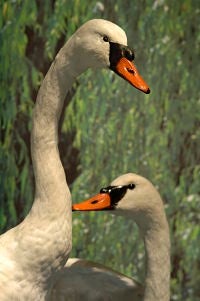
La página que intenta visitar sólo está disponible en inglés. ¡Disculpa!
The page you are about to visit is currently only available in English. Sorry!

 “People always come up with the argument that homosexuality is somehow against nature. And that’s not true." That's what Petter Bøckman told me a few years ago. Bøckman was the academic advisor for "Against Nature?" a 2006 exhibition at the Norwegian Natural History Museum of the University of Oslo that used models, photos, texts, and specimens (like the swans to the right) to inform visitors about a small selection of "gay" animals. Click here for photos from the exhibit of whales, giraffes, and bonobos.
“People always come up with the argument that homosexuality is somehow against nature. And that’s not true." That's what Petter Bøckman told me a few years ago. Bøckman was the academic advisor for "Against Nature?" a 2006 exhibition at the Norwegian Natural History Museum of the University of Oslo that used models, photos, texts, and specimens (like the swans to the right) to inform visitors about a small selection of "gay" animals. Click here for photos from the exhibit of whales, giraffes, and bonobos.
Scientists have observed homosexual behavior in hundreds of animal species, from insects to sheep. Recently a lesbian albatross pair made headlines around the globe—the couple will be raising a chick together at New Zealand's Taiaroa Head Royal Albatross Centre. The females were part of a trio, but the male left after mating with one of the females.
The royal albatross females will raise their chick exactly the same as any male-female pair would, Lyndon Perriman, a ranger with New Zealand's Department of Conservation, told the Telegraph."For the next six months the new parents will take turns to alternately guard and feed the chick, with one protecting it from predators while the other goes out to sea to forage for food several hundred kilometres away. They swap the roles every two days."
From Plenty:
Bonobos, one of our closest relatives, may be the most well-known homosexual animals.Killer whales, bottlenose dolphins, West Indian manatees, and giraffes are known to have all-male orgies. Among black-headed gulls, scientists estimate that one in ten pairs is comprised of two females. Same-sex penguin couples have been known to have long relationships and raise chicks.
Homosexuality is most widespread among animals with a complex herd life. It functions as a kind of social glue for bonobos, who use sex to diffuse conflict—a marked difference from other primates that solve conflicts with violence. Homosexuality also plays a social role among other male animals, such as big horn sheep and lions.
But researchers have no idea what the advantage is, if any, of homosexual behavior among dragonflies, scarab beetles, or, as observed at least once, two male octopuses of different species.
Bøckman and others at the museum hoped the exhibition would help break a long-held taboo against talking about, and publishing on, the subject. “We need more research,” he said.
An article in this week's New York Times magazine looks at some of the most recent research, and examines how biologists have largely turned a blind eye to same-sex pairings:
In recent years though, more biologists have been looking objectively at same-sex sexuality in animals — approaching it as real science. For Young, the existence of so many female-female albatross pairs disproved assumptions that she didn’t even realize she’d been making and, in the process, raised a chain of progressively more complicated questions. One of the prickliest, it seemed, was how a scientist is even supposed to talk about any of this, given how eager the rest of us have been to twist the sex lives of animals into allegories of our own. “This colony is literally the largest proportion of — I don’t know what the correct term is: ‘homosexual animals’? — in the world,” Young told me. “Which I’m sure some people think is a great thing, and others might think is not.”